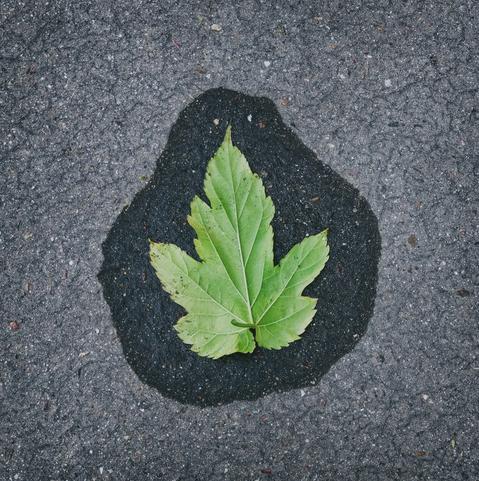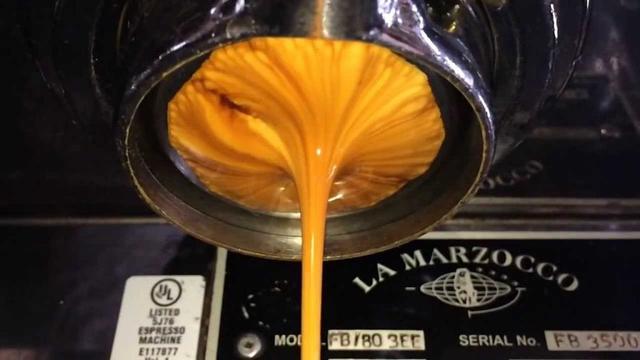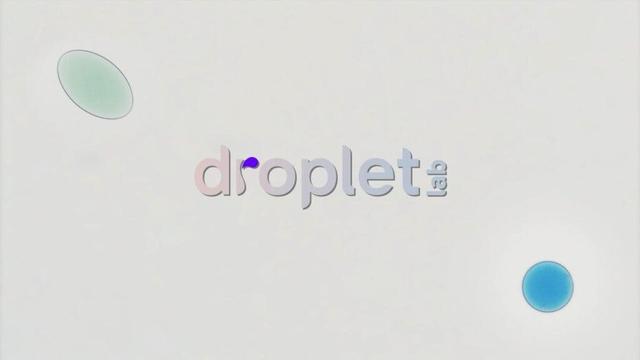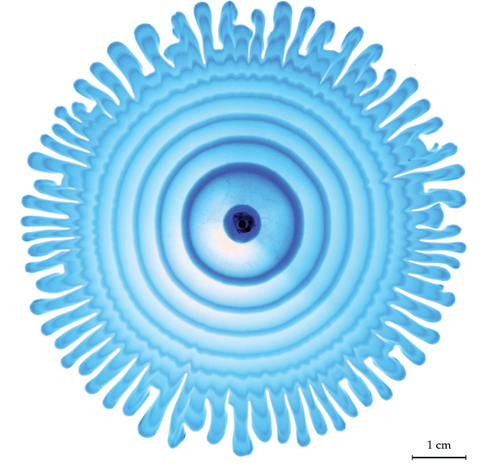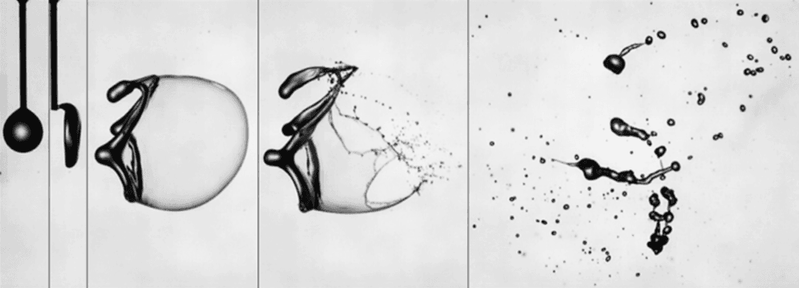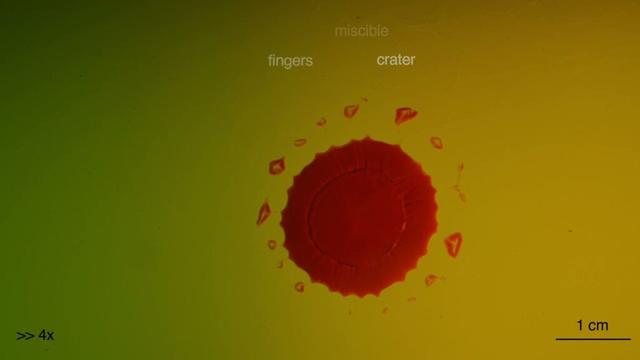#SurfaceTension
.
.
.
#EverydayPhoto #MyDailyShot #VisualDiary #PhotoChronicle #365Moments #DailyFrame #Acobas365 #PierreAcobas #CapturedToday #MomentsOf2025 #DailyVisuals #OneDayOnePhoto #Creative365 #Project365 #DailyPixels #PhotoStory #365DaysOfArt #DailyPhoto #NatureDetails #SurfaceTension #EvaporationArt
“Re:Birth”
In “Re:Birth,” videographer Vadim Sherbakov explores the fascinating patterns of ferrofluids, which suspend tiny ferrous particles in another liquid, often oil. When this magnetic liquid is mixed with ink or paint, its black lines take on a labyrinthine appearance. The result is rather psychedelic, especially with Sherbakov’s bold colors. (Video and image credit: V. Sherbakov)
#ferrofluid #fluidDynamics #fluidsAsArt #instability #physics #science #surfaceTension
The Science of Emulsions: Mixing Oil and Water? https://theblogofscience.com/the-science-of-emulsions-mixing-oil-and-water/
#EmulsionScience #FoodScience #Chemistry #CulinaryArts #ImmiscibleLiquids #Homogenization #SurfaceTension #FoodTechnology #Mayonnaise #StableMixture
Espresso in Slow-Mo
Espresso has some pretty cool physics. But it’s also just lovely to watch in slow motion. This video offers a look at the making of an espresso shot at 120 frames per second (though you can also enjoy a 1000 fps version here). Watching the film form, expand, and break up at the beginning and end of the video is my favorite, but watching how the occasional solid coffee grains make their way into and down the central jet is really interesting also. (Video and image credit: YouTube/skunkay; via Open Culture)
#espresso #flowVisualization #fluidDynamics #fluidsAsArt #highSpeedVideo #physics #science #surfaceTension
Dancing Metal Droplets
Droplets of a gallium alloy are liquid at room temperature. When spiked with aluminum grains and immersed in a solution of NaOH, the droplets change shape and move in a random fashion. This video delves into the phenomenon, describing how a chemical reaction with the aluminum grains changes the local surface tension and creates Marangoni flows that make the droplets move. To get the droplet motion, you need to have the aluminum concentration just right. With too little, there’s not enough Marangoni flow. With too much, the hydrogen gas produced in the chemical reaction disrupts the droplet motion. (Video and image credit: N. Kim)
https://www.youtube.com/watch?v=XYRj0Ty9udo
#2024gofm #chemistry #droplets #fluidDynamics #marangoniEffect #physics #science #surfaceTension
Building a Better Fog Harp
On arid coastlines, fog rolling in can serve as an important water source. Today’s fog collectors often use tight mesh nets. The narrow holes help catch tiny water particles, but they also clog easily. A few years ago, researchers suggested an alternative design — a fog harp inspired by coastal redwoods — that used closely spaced vertical wires to capture water vapor. At small scales, this technique worked well, but once scaled up to a meter-long fog harp, the strings would stick together once wet — much the way wet hairs cling to one another.
The group has iterated on their design with a new hybrid that maintains the fog harp’s close vertical spacing but adds occasional cross-wires to stabilize. Laboratory tests are promising, with the new hybrid fog harp collecting water with 2 – 8 times the efficiency of either a conventional mesh or their original fog harp. The team notes that even higher efficiencies are possible with electrification. (Image credit: A. Parrish; research credit: J. Kaindu et al.; via Ars Technica)
#condensation #elastocapillarity #fluidDynamics #fog #fogCollection #physics #science #surfaceTension
How Insects Fly in the Rain
Getting caught in the rain is annoying for us but has the potential to be deadly for smaller creatures like insects. So how do they survive a deluge? First, they don’t resist a raindrop, and second, they have the kinds of surfaces water likes to roll or bounce off. The key to this second ability is micro- and nanoscale roughness. Surfaces like butterfly wings, water strider feet, and leaf surfaces contain lots of tiny gaps where air gets caught. Water’s cohesion — its attraction to itself — is large enough that water drops won’t squeeze into these tiny spaces. Instead, like the ball it resembles, a water drop slides or bounces away. (Video and image credit: Be Smart)
#biology #butterfly #cohesion #droplets #fluidDynamics #hydrophobic #insects #physics #science #superhydrophobic #surfaceRoughness #surfaceTension
“Legend”
Filmmaker Roman De Giuli returns to his roots with this short fluid-filled film inspired by the color gold. He combines paint, ink, powders, and particles in a mix of micro- and macroscale photography. As always, the results are a mesmerizing plethora of fluid phenomena: Marangoni flows, turbulence, vorticity, viscous fingering and so much more. (Video and image credit: R. De Giuli)
#fluidDynamics #fluidsAsArt #instability #physics #science #surfaceTension #turbulence
Все Заєбісь
#SurfaceTension
Music for today <<https://www.youtube.com/watch?v=fGurgeglzcI >> #Lights #SURFACETENSION #MV #新曲公開 #オリジナル曲 #newmusic #newrelease2025 #Music🐾
Explosively Jetting
Dropping water from a plastic pipette onto a pool of oil electrically charges the drop. Then, as it evaporates, it shrinks and concentrates the charges closer and closer. Eventually, the strength of the electrical charge overcomes surface tension, making the drop form a cone-shaped edge that jets out tiny, highly-charged microdrops. Afterward, the drop returns to its spherical shape… until shrinkage builds up the charge density again. This microjetting behavior can carry on for hours! (Video and image credit: M. Lin et al.; research preprint: M. Lin et al.)
#2024gofm #droplets #electrostaticCharge #fluidDynamics #jetting #magnetohydrodynamics #physics #satelliteDroplets #science #sessileDrop #surfaceTension
Flow Behind Viscous Fingers
Nature is full of branching patterns: trees, lighting, rivers, and more. In fluid dynamics, our prototypical branching pattern is the Saffman-Taylor instability, created when a less viscous fluid is injected into a more viscous one in an confined space. Most attention in this problem has gone to the branching interface where the two fluids meet, but recently, a team has examined the flow away from the fingers by alternately injecting dyed and undyed fluid to visualize what goes on. That’s what we see here. Notice how the central dye rings, far from the branching fingers, still appear circular. Yet, even a few centimeters away from the fingers, the dye is starting to show ripples that correspond to the fingers. That’s an indication that the pressure gradient generated at the tips of the fingers is pretty far-reaching! (Image and research credit: S. Gowen et al.)
#flowVisualization #fluidDynamics #HeleShawCell #physics #SaffmanTaylorInstability #science #surfaceTension
#springtail #globularspringtail #nature #wildlife #ecology #water #surfacetension #floating #cleaning #selfcare #biodiversity #animal #arthropod #scotland #soilanimal #cuteanimals
Within a Drop
In this macro video, various chemical reactions swirl inside a single dangling droplet. Despite its tiny size, quite a lot can go on in a drop like this. Both the injection of chemicals and the chemical reactions themselves can cause the flows we see here. Surface tension variations and capillary waves on the exterior of the drop can play a role, too. Just because a flow is tiny doesn’t mean it’s simple. (Video and image credit: B. Pleyer; via Nikon Small World in Motion)
Chemical reactions swirl within a single, hanging droplet.#chemistry #droplets #flowVisualization #fluidDynamics #fluidsAsArt #marangoniEffect #physics #science #surfaceTension
@Nfoonf @catsalad @claudius yes.
It's #Felinofuidity or rather heat expansion and decreased viscosity of #Felinofluid...
The only reason it doesn't drop to the floor is it's extreme #SurfaceTension and #Cohesion resulting in a very strong bond of the #blob...
Active Cheerios Self-Propel
The interface where air and water meet is a special world of surface-tension-mediated interactions. Cereal lovers are well-aware of the Cheerios effect, where lightweight O’s tend to attract one another, courtesy of their matching menisci. And those who have played with soap boats know that a gradient in surface tension causes flow. Today’s pre-print study combines these two effects to create self-propelling particle assemblies.
The team 3D-printed particles that are a couple centimeters across and resemble a cone stuck atop a hockey puck. The lower disk area is hollow, trapping air to make the particle buoyant. The cone serves as a fuel tank, which the researchers filled with ethanol (and, in some cases, some fluorescent dye to visualize the flow). Like soap, ethanol’s lower surface tension disrupts the water’s interface and triggers a flow that pulls the particle toward areas with higher surface tension. But, unlike soap, ethanol evaporates, effectively restoring the interface’s higher surface tension over time.
With multiple self-propelling particles on the interface, the researchers observed a rich series of interactions. Without their fuel, the Cheerios effect attracted particles to each other. But with ethanol slowly leaking out their sides, the particles repelled each other. As the ethanol ran out and evaporated, the particles would again attract. By tweaking the number and position of fuel outlets on a particle, the researchers found they could tune the particles’ attractions and motility. In addition to helping robots move and organize, their findings also make for a fun educational project. There’s a lot of room for students to play with different 3D-printed designs and fuel concentrations to make their own self-propelled particles. (Research and image credit: J. Wilt et al.; via Ars Technica)
#3DPrinting #CheeriosEffect #DIYFluids #evaporation #flowVisualization #fluidDynamics #marangoniEffect #physics #science #surfaceTension
Predicting Droplet Sizes
Squeeze a bottle of cleaning spray, and the nozzle transforms a liquid jet into a spray of droplets. These droplets come in many sizes, and predicting them is difficult because the droplets’ size distribution depends on the details of how their parent liquid broke up. Shown above is a simplified experimental version of this, beginning with a jet of air striking a spherical water droplet on the far left. In less than 3 milliseconds, the droplet has flattened into a pancake shape. In another 4 milliseconds, the pancake has ballooned into a shape called a bag, made up of a thin, curved water sheet surrounded by a thicker rim. A mere 10 milliseconds after the jet and drop first meet, the liquid is now a spray of smaller droplets.
Researchers have found that the sizes of these final droplets depend on the balance between the airflow and the drop’s surface tension; these two factors determine how the drop breaks up, whether that’s rim first, bag first, or due to a collision between the bag and rim. (Image credit: I. Jackiw et al.; via APS Physics)
#atomization #bag #droplets #flowVisualization #fluidDynamics #physics #science #sprays #surfaceTension
Under a macro lens, even a petri dish worth of fluids comes vividly to life. Here, artist Scott Portingale explores crystallization, Marangoni effects, and other phenomena alongside a haunting soundtrack from musician Gorkem Sen. Enjoy! (Image and video credit: S. Portingale et al.)
https://fyfluiddynamics.com/2024/11/chemical-somnia/
#crystalGrowth #fluidDynamics #fluidsAsArt #instability #marangoniEffect #physics #science #surfaceTension
When surface tension varies along an interface, fluids move from regions of low surface tension to higher surface tension, a behavior known as the Marangoni effect. Here, a drop of (dyed) water is placed on glycerol. The two fluids are miscible, but water has much a lower viscosity and density yet a higher surface tension. The drop’s interface quickly becomes unstable; viscous fingers form along the edge as the less viscous water pushes into the more viscous glycerol. Eventually, the surface-tension-driven Marangoni flow breaks those fingers off into lip-like daughter drops. The researchers also show how the interplay between viscosity and surface tension affects the size of fingers that form by varying the water/glycerol concentration. (Image and video credit: A. Hooshanginejad et al.)
https://fyfluiddynamics.com/2024/10/marangoni-blossoms/
#2021gofm #fluidDynamics #instability #marangoniEffect #physics #science #surfaceTension #viscosity #viscousFingering
